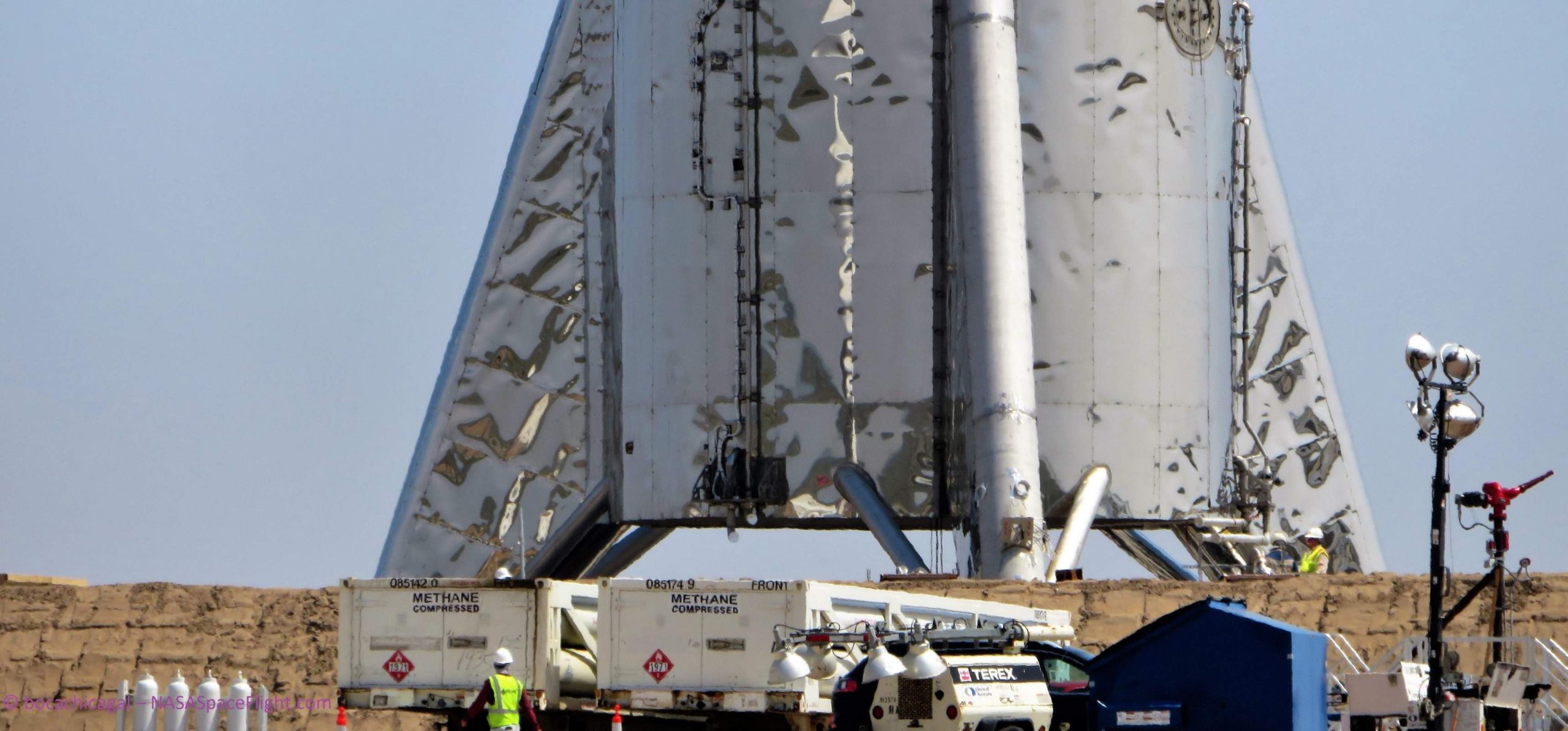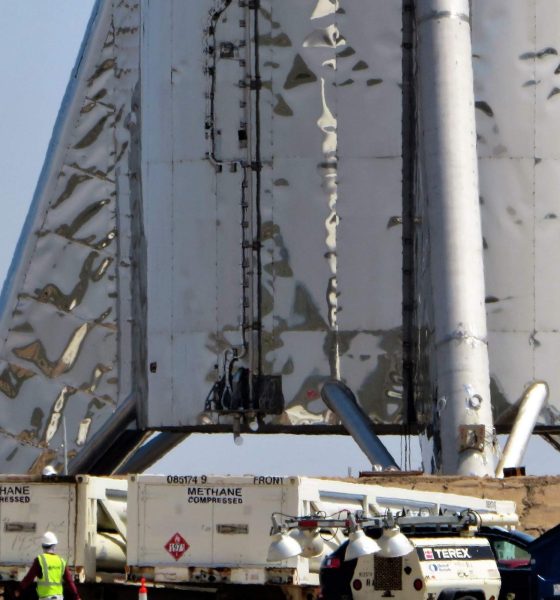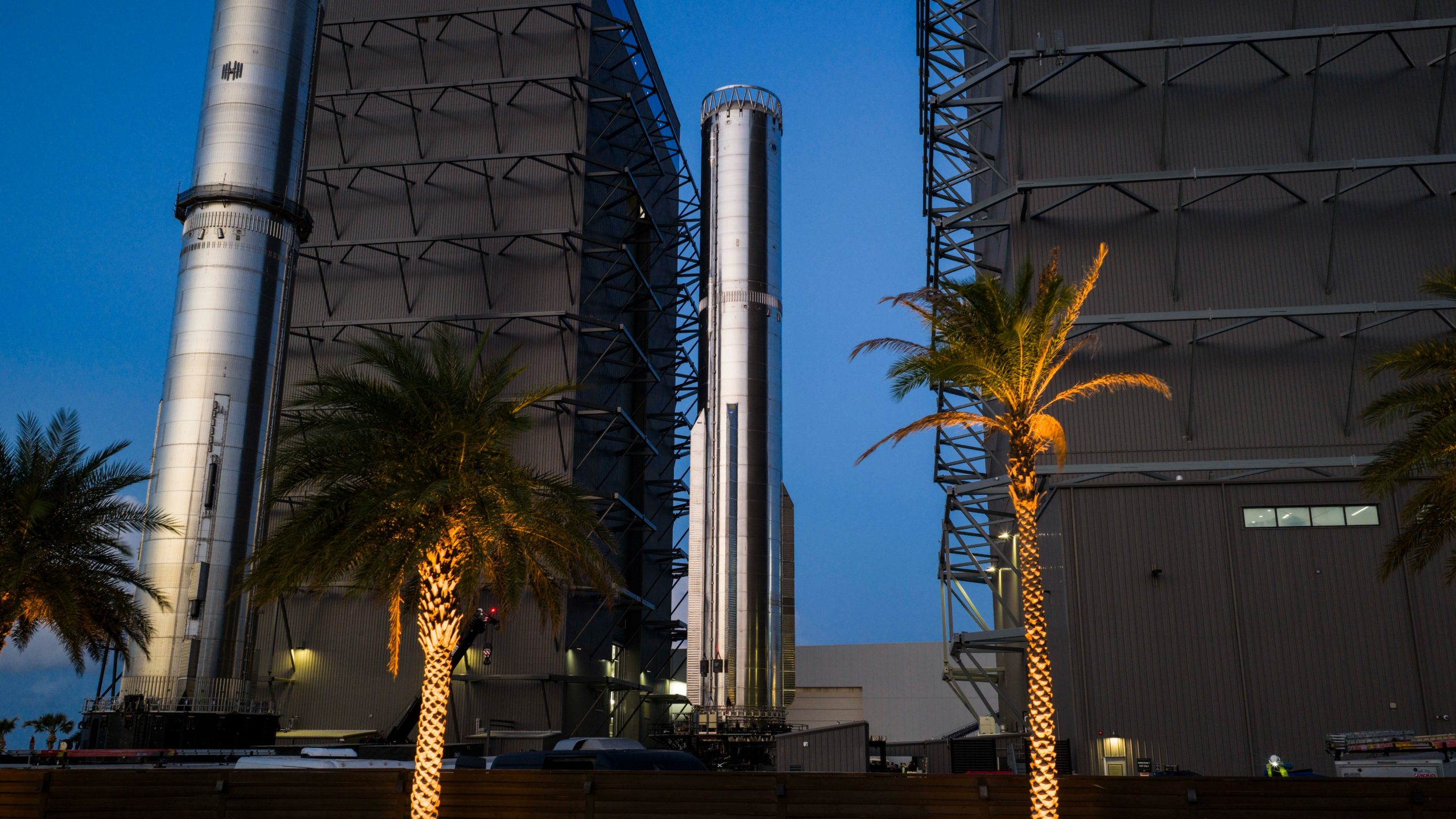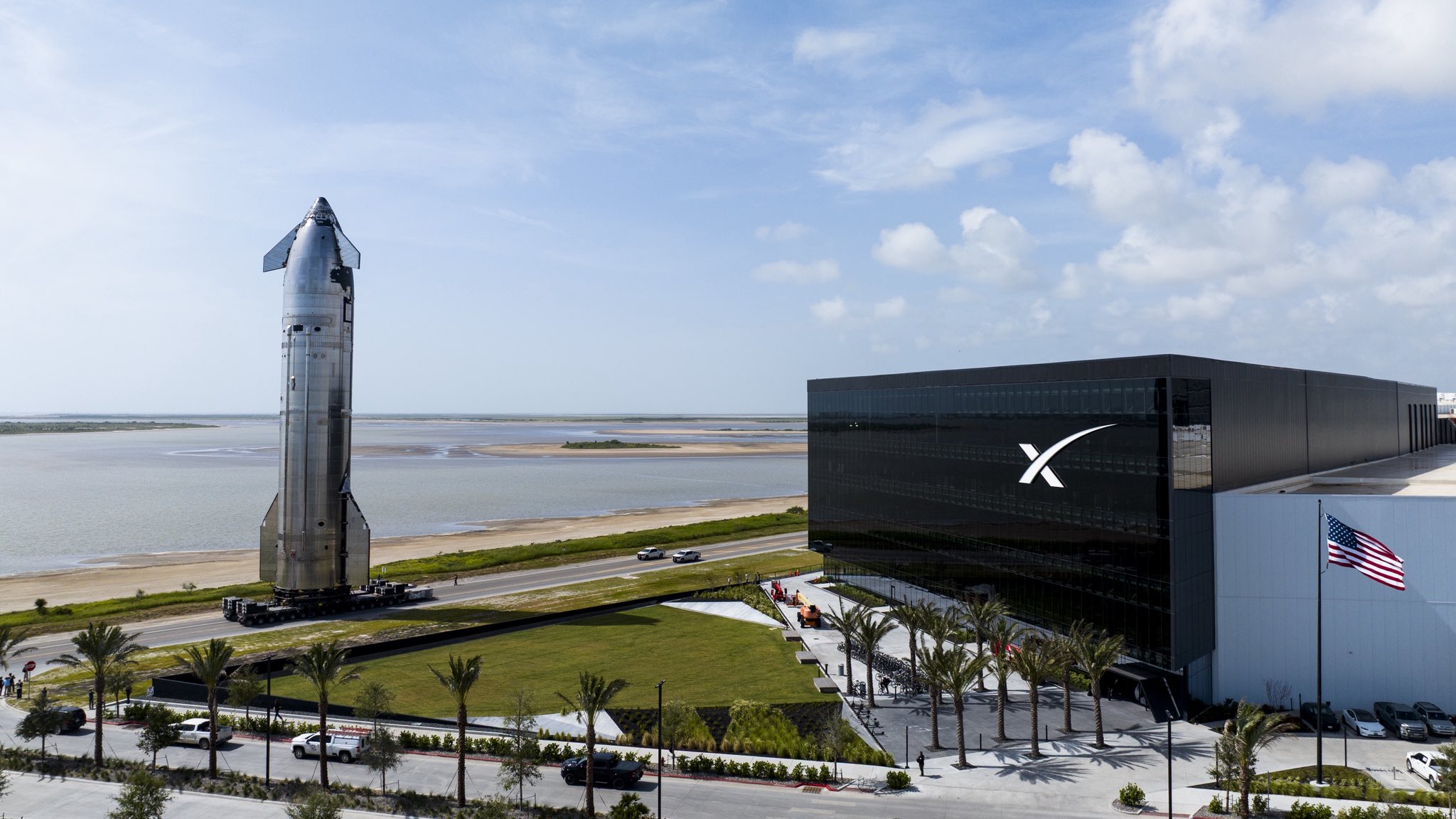

SpaceX
SpaceX’s Elon Musk says Raptor will be installed on Starship prototype this week
Speaking on Friday, March 8th, SpaceX CEO Elon Musk announced that the company’s second completed Raptor engine was already “on [its] way to [Star]hopper” to – nominally – be installed on the prototype vehicle as early as the week of March 11th (this week).
According to an official SpaceX statement, once Raptor is installed on Starhopper, the integrated vehicle will perform a combination of ground systems testing, propellant loading, static fire tests, and low-altitude hover demonstrations to prove out the brand new vehicle, engine, and facilities. Prior to the final months of 2018, the build site, launch pad, and prototype Starship now preparing for imminent hop tests were little more than empty dirt lots on the southern tip of the Texas coast.
“SpaceX will conduct checkouts of the newly installed ground systems and perform a short static fire test in the days ahead,” he said. “Although the prototype is designed to perform sub-orbital flights, or hops, powered by the SpaceX Raptor engine, the vehicle will be tethered during initial testing and hops will not be visible from offsite. SpaceX will establish a safety zone perimeter in coordination with local enforcement and signage will be in place to alert the community prior to the testing.” – James Gleeson, March 8th, SpaceX
Prior to February 3rd, barely one month ago, SpaceX’s next-generation Raptor engine had yet to even ignite in its final(ish), full-scale form. Less than two weeks after that, SpaceX’s propulsion team had pushed the engine to the point of damage, quite possibly throttling it above its nominal max thrust and main combustion chamber pressures. According to Musk, Raptor serial number 2 (SN02) will feature moderate changes to mitigate the cause of that damage.
Along the path to hop tests, it’s unclear if Raptor SN02 – following the mild problems more or less intentionally forced upon its predecessor – will be test-fired at SpaceX’s McGregor, Texas development facilities before heading south to be installed on Starhopper. Given SpaceX’s methodical approach to engine and vehicle testing prior to the launch of any of its rockets, chances are good that it will have already conducted a number of basic acceptance tests in McGregor. If Musk is to be taken literally, the second
It has not yet been confirmed if Starhopper will initially perform static fire and hop tests with just one Raptor installed, but the sheer power of the fairly compact engine (upwards of 200 metric tons or 450,000 lbf of thrust at full throttle) should more than enable an extremely heavy prototype to lift off even with 50+ metric tons of propellant onboard. While it could simply be a matter of convenience and efficiency to start integrated Starhopper testing immediately instead of waiting for the completion of additional Raptor engines, the process of testing a thrust structure or integrated rocket with an increasing number of engines installed is a relatively common practice in aerospace. Regardless of its history, SpaceX itself also began its first integrated testing of a Falcon 9 first stage in the same way, starting with one Merlin engine installed and ultimately graduating to 3, 5, and the final 9 engines over the course of a few months of testing.

While Starhopper is unlikely to need more than a handful of Raptor engines to exhaust its usefulness, the first orbital Starship prototype – and, even more so, the first Super Heavy booster – will almost certainly end up going through the same process of methodical hot-fire testing before SpaceX even thinks of attempting the first orbital BFR launch. Featuring 7 and 31 Raptors respectively, Starship and Super Heavy will radically push the envelope of both SpaceX’s own experience and the aerospace industry as a whole, potentially becoming the most powerful liquid rocket ever launched if or when the vehicle begins flight tests with both stages.
Check out Teslarati’s Marketplace! We offer Tesla accessories, including for the Tesla Cybertruck and Tesla Model 3.

Elon Musk
SpaceX issues statement on Starship V3 Booster 18 anomaly
The incident unfolded during gas-system pressure testing at the company’s Massey facility in Starbase, Texas.

SpaceX has issued an initial statement about Starship Booster 18’s anomaly early Friday. The incident unfolded during gas-system pressure testing at the company’s Massey facility in Starbase, Texas.
SpaceX’s initial comment
As per SpaceX in a post on its official account on social media platform X, Booster 18 was undergoing gas system pressure tests when the anomaly happened. Despite the nature of the incident, the company emphasized that no propellant was loaded, no engines were installed, and personnel were kept at a safe distance from the booster, resulting in zero injuries.
“Booster 18 suffered an anomaly during gas system pressure testing that we were conducting in advance of structural proof testing. No propellant was on the vehicle, and engines were not yet installed. The teams need time to investigate before we are confident of the cause. No one was injured as we maintain a safe distance for personnel during this type of testing. The site remains clear and we are working plans to safely reenter the site,” SpaceX wrote in its post on X.
Incident and aftermath
Livestream footage from LabPadre showed Booster 18’s lower half crumpling around the liquid oxygen tank area at approximately 4:04 a.m. CT. Subsequent images posted by on-site observers revealed extensive deformation across the booster’s lower structure. Needless to say, spaceflight observers have noted that Booster 18 would likely be a complete loss due to its anomaly.
Booster 18 had rolled out only a day earlier and was one of the first vehicles in the Starship V3 program. The V3 series incorporates structural reinforcements and reliability upgrades intended to prepare Starship for rapid-reuse testing and eventual tower-catch operations. Elon Musk has been optimistic about Starship V3, previously noting on X that the spacecraft might be able to complete initial missions to Mars.
Elon Musk
SpaceX Starship Version 3 booster crumples in early testing
Photos of the incident’s aftermath suggest that Booster 18 will likely be retired.

SpaceX’s new Starship first-stage booster, Booster 18, suffered major damage early Friday during its first round of testing in Starbase, Texas, just one day after rolling out of the factory.
Based on videos of the incident, the lower section of the rocket booster appeared to crumple during a pressurization test. Photos of the incident’s aftermath suggest that Booster 18 will likely be retired.
Booster test failure
SpaceX began structural and propellant-system verification tests on Booster 18 Thursday night at the Massey’s Test Site, only a few miles from Starbase’s production facilities, as noted in an Ars Technica report. At 4:04 a.m. CT on Friday, a livestream from LabPadre Space captured the booster’s lower half experiencing a sudden destructive event around its liquid oxygen tank section. Post-incident images, shared on X by @StarshipGazer, showed notable deformation in the booster’s lower structure.
Neither SpaceX nor Elon Musk had commented as of Friday morning, but the vehicle’s condition suggests it is likely a complete loss. This is quite unfortunate, as Booster 18 is already part of the Starship V3 program, which includes design fixes and upgrades intended to improve reliability. While SpaceX maintains a rather rapid Starship production line in Starbase, Booster 18 was generally expected to validate the improvements implemented in the V3 program.
Tight deadlines
SpaceX needs Starship boosters and upper stages to begin demonstrating rapid reuse, tower catches, and early operational Starlink missions over the next two years. More critically, NASA’s Artemis program depends on an on-orbit refueling test in the second half of 2026, a requirement for the vehicle’s expected crewed lunar landing around 2028.
While SpaceX is known for diagnosing failures quickly and returning to testing at unmatched speed, losing the newest-generation booster at the very start of its campaign highlights the immense challenge involved in scaling Starship into a reliable, high-cadence launch system. SpaceX, however, is known for getting things done quickly, so it would not be a surprise if the company manages to figure out what happened to Booster 18 in the near future.
Elon Musk
SpaceX’s next project will produce Starships at a level that sounds impossible
1,000 rockets per year is an insane number, especially considering Starship’s sheer size.

Elon Musk has revealed bold plans for SpaceX’s newest Starbase facility in Texas, predicting it will become a birthplace for “so many spaceships.” The upcoming “Gigabay,” a massive $250 million production hub in Starbase, Texas, is designed to manufacture up to 1,000 Starship rockets per year.
That’s an insane number of rockets for a single facility, especially considering Starship’s sheer size.
One of the world’s largest industrial structures
SpaceX’s Gigabay is expected to stand roughly 380 feet tall and enclose 46.5 million cubic feet of interior space, making it one of the largest industrial structures to date. The facility will feature 24 dedicated work cells for assembling and refurbishing Starship and Super Heavy vehicles, complete with heavy-duty cranes capable of lifting up to 400 U.S. tons, as noted in a Times of India report.
Construction crews have already placed four tower cranes on-site, with completion targeted for December 2026. Once operational, the Gigabay is expected to boost SpaceX’s launch cadence dramatically, as it would be able to build up to 1,000 reusable Starships per year, as noted in a report from the Dallas Express. Musk stated that the Gigabay will be “one of the biggest structures in the world” and hinted that it represents a major leap in Starbase’s evolution from test site to full-scale production hub.
A key step toward Mars and beyond
Starship is SpaceX’s heavy-lift rocket system, and it remains a key part of Elon Musk’s vision of a multiplanetary future. The vehicle can carry 100–150 tonnes to low Earth orbit and up to 250 tonnes in expendable mode. With several successful flights to date, including a perfect 11th test flight, the Starship program continues to refine its reusable launch system ahead of crewed lunar missions under NASA’s Artemis initiative.
Starship is unlike any other spacecraft that has been produced in the past. As per Elon Musk, Starship is a “planet-colonizer” class rocket, as the magnitude of such a task “makes other space transport task trivial.” Considering Starship’s capabilities, it could indeed become the spacecraft that makes a Moon or Mars base feasible.








